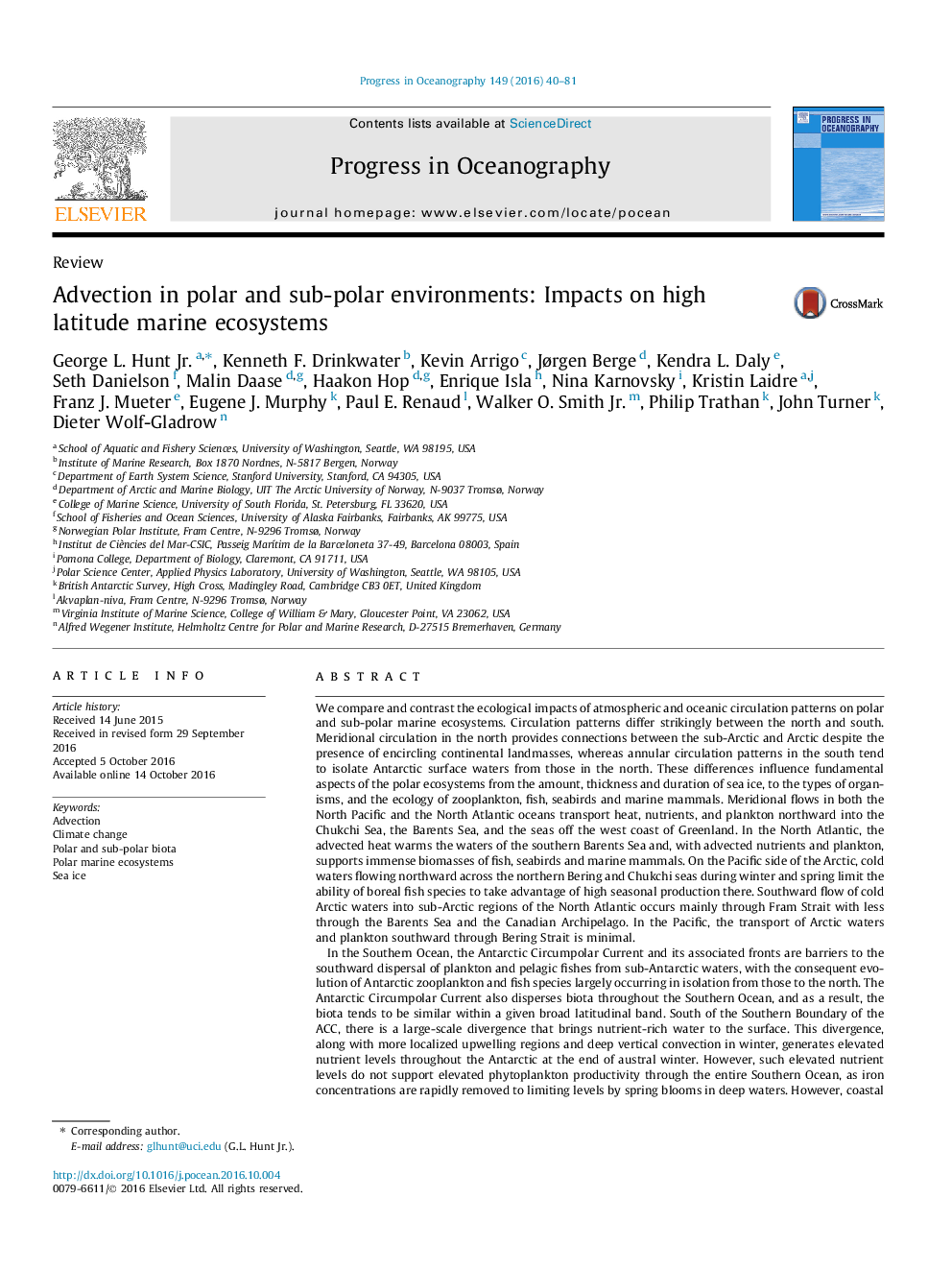| کد مقاله | کد نشریه | سال انتشار | مقاله انگلیسی | نسخه تمام متن |
|---|---|---|---|---|
| 4552914 | 1627909 | 2016 | 42 صفحه PDF | دانلود رایگان |
• Advection connects the Arctic with lower latitudes but isolates the Southern Ocean.
• Northward flowing waters have impact on Arctic productivity at all trophic levels.
• Arctic & Antarctic benthos, zooplankton & fish have contrasting evolutionary histories.
• Subpolar & polar fish, seabirds and marine mammals depend on advection of zooplankton.
• Climate change will affect polar marine ecosystem structure, function & connectivity.
We compare and contrast the ecological impacts of atmospheric and oceanic circulation patterns on polar and sub-polar marine ecosystems. Circulation patterns differ strikingly between the north and south. Meridional circulation in the north provides connections between the sub-Arctic and Arctic despite the presence of encircling continental landmasses, whereas annular circulation patterns in the south tend to isolate Antarctic surface waters from those in the north. These differences influence fundamental aspects of the polar ecosystems from the amount, thickness and duration of sea ice, to the types of organisms, and the ecology of zooplankton, fish, seabirds and marine mammals. Meridional flows in both the North Pacific and the North Atlantic oceans transport heat, nutrients, and plankton northward into the Chukchi Sea, the Barents Sea, and the seas off the west coast of Greenland. In the North Atlantic, the advected heat warms the waters of the southern Barents Sea and, with advected nutrients and plankton, supports immense biomasses of fish, seabirds and marine mammals. On the Pacific side of the Arctic, cold waters flowing northward across the northern Bering and Chukchi seas during winter and spring limit the ability of boreal fish species to take advantage of high seasonal production there. Southward flow of cold Arctic waters into sub-Arctic regions of the North Atlantic occurs mainly through Fram Strait with less through the Barents Sea and the Canadian Archipelago. In the Pacific, the transport of Arctic waters and plankton southward through Bering Strait is minimal.In the Southern Ocean, the Antarctic Circumpolar Current and its associated fronts are barriers to the southward dispersal of plankton and pelagic fishes from sub-Antarctic waters, with the consequent evolution of Antarctic zooplankton and fish species largely occurring in isolation from those to the north. The Antarctic Circumpolar Current also disperses biota throughout the Southern Ocean, and as a result, the biota tends to be similar within a given broad latitudinal band. South of the Southern Boundary of the ACC, there is a large-scale divergence that brings nutrient-rich water to the surface. This divergence, along with more localized upwelling regions and deep vertical convection in winter, generates elevated nutrient levels throughout the Antarctic at the end of austral winter. However, such elevated nutrient levels do not support elevated phytoplankton productivity through the entire Southern Ocean, as iron concentrations are rapidly removed to limiting levels by spring blooms in deep waters. However, coastal regions, with the upward mixing of iron, maintain greatly enhanced rates of production, especially in coastal polynyas. In these coastal areas, elevated primary production supports large biomasses of zooplankton, fish, seabirds, and mammals. As climate warming affects these advective processes and their heat content, there will likely be major changes in the distribution and abundance of polar biota, in particular the biota dependent on sea ice.
Journal: Progress in Oceanography - Volume 149, December 2016, Pages 40–81
